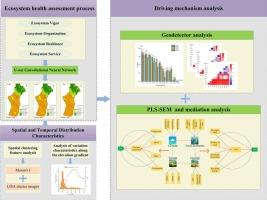自然因素和人类社会经济活动对中亚干旱区生态系统健康的影响机制——以西北富云地区为例
IF 7
2区 环境科学与生态学
Q1 ENVIRONMENTAL SCIENCES
引用次数: 0
摘要
生态系统健康是生态系统管理的一个重要重点。了解生态系统健康的空间分布格局和驱动因素对有效治理和恢复至关重要。然而,在干旱牧区的研究仍然有限。本研究对新疆阿勒泰地区代表性牧区富云县的生态系统健康状况进行了调查。利用基于深度学习的活力-组织-弹性-服务(VORS)框架,分析了2000年、2010年和2020年不同海拔梯度下生态系统健康指数(EHI)的时空变化特征及其与自然和人文社会经济因素的相关性。随后,采用偏最小二乘结构方程模型(PLS-SEM)和中介分析探讨了影响因素之间的相互作用机制,并阐明了EHI变化的驱动因素。结果表明:(1)EHI具有显著的空间异质性,沿海拔梯度由北向南递减。(2)潜在蒸散发(PET)、温度和降水是EHI空间分异的主要驱动因素。在10年内,气候因素主导了EHI的变化,而在20多年中,人口密度和人均GDP等社会经济变量成为主要驱动因素。(3)中低海拔地区(460 ~ 2460 m) EHI与降水呈显著正相关。在高海拔地区(2460 m以上),EHI与气温和潜在蒸散量均呈正相关。自然活动和人类社会经济活动对中低海拔地区生态系统健康影响显著,而人类社会经济活动对高海拔地区生态系统健康影响不显著。(4) PET作为一个中介,放大了温度对EHI的负面影响,减弱了降水和数字高程模型(DEM)对EHI的正面影响,强化了坡度对EHI的正面影响。同时,中介放牧压力指数减弱了人均GDP和人口密度对生态效益的负面影响,增强了道路距离和草地比例对生态效益的正向影响。研究结果为牧区生态保护、促进可持续发展提供了有价值的政策见解和科学指导。本文章由计算机程序翻译,如有差异,请以英文原文为准。

Influence mechanism of natural factors and human socio-economic activities on ecosystem health in arid regions of Central Asia: A case study of Fuyun area, northwest China
Ecosystem health is a critical focus in ecosystem management. Understanding the spatial distribution patterns and driving factors of ecosystem health is crucial for efficient governance and restoration. However, research in arid pastoral regions remains limited. This research examined the ecosystem health of Fuyun County, a representative pastoral area located in the Altay Prefecture of Xinjiang, China. Utilizing a deep learning-based Vigor-Organization-Resilience-Service (VORS) framework, this paper evaluated the spatio-temporal variation characteristics of the ecosystem health index (EHI) and its correlation with natural and human socio-economic factors across different elevation gradients in 2000, 2010, and 2020. Subsequently, the Partial Least Squares Structural Equation Modeling (PLS-SEM) and mediation analysis were employed to investigate the interactive mechanisms among influencing factors and elucidate the drivers of EHI changes.
The findings indicated that: (1) EHI exhibited significant spatial heterogeneity, decreasing along the elevation gradient from north to south. (2) Potential evapotranspiration (PET), temperature, and precipitation were the primary drivers of EHI spatial differentiation. Within a decade, climate factors dominated EHI changes, whereas over two decades, socio-economic variables such as population density and per capita GDP became primary drivers. (3) In low- and medium-elevation regions (460–2460 m), EHI was positively correlated with precipitation. In high-elevation areas (above 2460 m), EHI showed a positive correlation with both temperature and potential evapotranspiration. Natural and human socio-economic activities significantly impacted ecosystem health in low- and medium-elevation regions, while human socio-economic activities had no significant influence in high altitude regions. (4) As a mediator, PET amplified the negative effect of temperature on EHI, weakened the positive impact of precipitation and the digital elevation model (DEM) on EHI, and strengthened the positive influence of slope on EHI. Meanwhile, the mediator grazing pressure index weakened the negative impact of per capita GDP and population density on EHI, but enhanced the positive effects of distance from roads and the proportion of grassland on EHI. These results offer valuable policy insights and scientific guidance for ecological conservation, promoting sustainable development in pastoral regions.
求助全文
通过发布文献求助,成功后即可免费获取论文全文。
去求助
来源期刊

Ecological Indicators
环境科学-环境科学
CiteScore
11.80
自引率
8.70%
发文量
1163
审稿时长
78 days
期刊介绍:
The ultimate aim of Ecological Indicators is to integrate the monitoring and assessment of ecological and environmental indicators with management practices. The journal provides a forum for the discussion of the applied scientific development and review of traditional indicator approaches as well as for theoretical, modelling and quantitative applications such as index development. Research into the following areas will be published.
• All aspects of ecological and environmental indicators and indices.
• New indicators, and new approaches and methods for indicator development, testing and use.
• Development and modelling of indices, e.g. application of indicator suites across multiple scales and resources.
• Analysis and research of resource, system- and scale-specific indicators.
• Methods for integration of social and other valuation metrics for the production of scientifically rigorous and politically-relevant assessments using indicator-based monitoring and assessment programs.
• How research indicators can be transformed into direct application for management purposes.
• Broader assessment objectives and methods, e.g. biodiversity, biological integrity, and sustainability, through the use of indicators.
• Resource-specific indicators such as landscape, agroecosystems, forests, wetlands, etc.
 求助内容:
求助内容: 应助结果提醒方式:
应助结果提醒方式:


